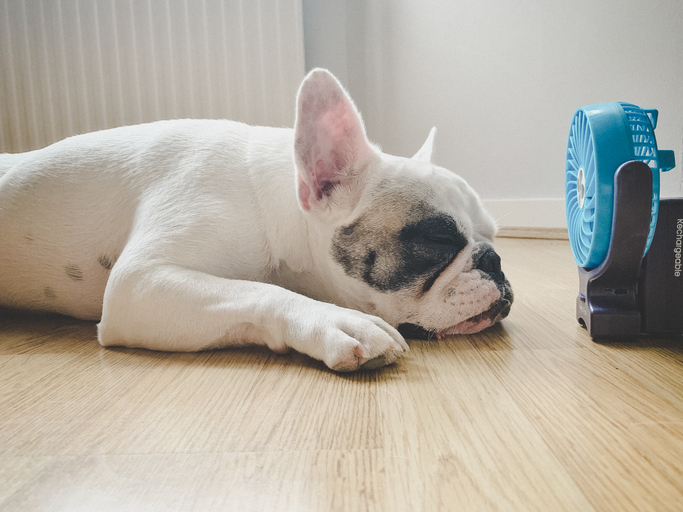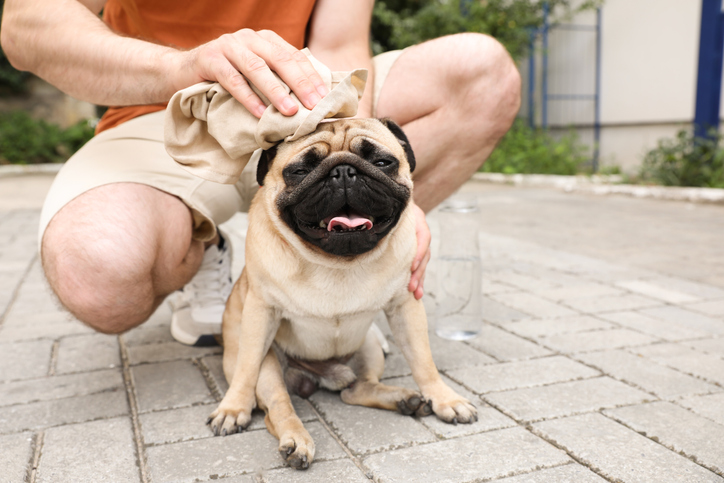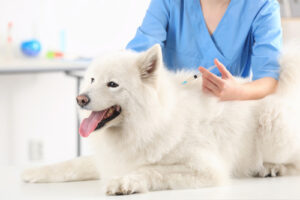We all know that leaving dogs outside in very cold weather can be dangerous for them. The same is true for leaving your dog out on a very hot day. This is because dogs are at risk of developing heat stroke in hot weather.
Heat stroke varies in severity, with the most severe also being the most life-threatening. Neurological symptoms of heat stroke in dogs are the most severe. However, all levels of heat stroke warrant a call to the vet.
In this article, we will be describing all the symptoms of heat stroke in dogs that dog owners should know about. We will also be explaining how heat stroke occurs and what you should do if your dog is exhibiting signs of heat stroke. Additionally, we will also be giving you some helpful tips on how to prevent heat stroke in dogs. Let’s get into it.

How Does Heat Stroke in Dogs Occur
Heat stroke in dogs occurs when they cannot cool themselves down naturally. Usually, this occurs in very hot weather or when a dog is locked in a hot car. Since dogs cool themselves down through panting, dogs that have a hard time panting effectively are more susceptible to heat stroke. This mainly includes brachycephalic dog breeds like English Bulldogs, French Bulldogs, and Pugs. Elderly and overweight dogs are more at risk for developing heat stroke as well.
The Symptoms of Heat Stroke in Dogs to Look Out For
Like many types of conditions, heat stroke ranges in severity. As a result, a dog with minor heat stroke will likely exhibit different and more mild symptoms than a dog with very severe heat stroke. Here we will be describing the different symptoms of heat stroke in dogs that you should look out for, and we will be categorizing them based on severity.
Signs of Minor Heat Stroke
Minor signs of heat stroke occur soon after the condition sets in. The main symptoms of minor heat stroke include:
- Excessive panting
- Excessive drooling
- Bright red gums and tongue
- Skin that is hot to the touch
- Fatigue
- Signs of dehydration
- A dry nose and eyes
- An elevated heart rate
The prognosis for treating minor heat stroke is usually pretty good as long as you work towards cooling them down and seeking medical attention immediately. As a result, it is always best to call your vet even if your dog is only exhibiting minor signs of heat stroke.
Signs of Moderate Heat Stroke
When it comes to moderate heat stroke, most dogs exhibit the same symptoms as minor heat stroke. However, these symptoms are usually more intense and noticeable. In addition, you may also notice hyperactivity and difficulty maintaining balance in a dog with moderate heat stroke.
Moderate heat stroke is still dangerous, so you should definitely call your vet immediately if your dog is showing signs. This way they can instruct you on how to cool your dog down slowly and prepare for you to bring your dog into the vet’s office.
Signs of Severe Heat Stroke
Dogs will have severe heat stroke when they start exhibiting signs of shock. Signs of severe heat stroke in dogs include:
- White or blue nose, gums, and tongue (also potentially around the eyes)
- Rapid heat rate with a drop in blood pressure (heart rate becomes irregular if left untreated)
- Quick and labored breathing
- Dilated pupils
- Signs of severe dehydration
- Muscle tremors
- Seizures
- Extreme lethargy
- Urinating and/or defecating uncontrollably
- Collapse
Severe heat stroke is a life-threatening condition in dogs. As a result, it should be treated as a medical emergency, and dogs exhibiting signs of severe heat stroke should be taken to an emergency vet immediately.
What Should You do if Your Dog Shows Signs of Heat Stroke?
If your dog is exhibiting signs of heat stroke, don’t panic. It is important to act quickly and precisely to give your dog proper care. Here is what you should do if your dog is showing any symptoms of heat stroke.
Call Your Vet
The first thing that you should do if you suspect that your dog is suffering from heat stroke is call your vet, even if your dog is only showing mild symptoms. Calling your vet will help you determine if your dog’s situation is life-threatening or not. A vet will also be able to instruct you on how to cool your dog down both safely and gradually.
Work Towards Cooling Them Down Gradually
If your dog is not experiencing signs of shock, your vet will likely recommend that you work towards cooling your dog down gradually before bringing them into the vet’s office. For mild cases of heat stroke, giving your dog some water and taking them into an air-conditioned space is usually enough to get them back to normal.
For more advanced cases, cooling your dog gradually with cool (not cold) water will help. Gently splash the cool water on them with a towel or washcloth. It is a good idea to frequently check your dog’s temperature when doing this to prevent hypothermia. Stop doing this once your dog’s temperature is in the normal range.
Can Heat Stroke be Life-Threatening to Dogs?
Yes, heat stroke can be life-threatening to dogs when left untreated. Of course, severe heat stroke is the most dangerous. However, even mild heat stroke can quickly progress when left untreated. This is why knowing the symptoms of heat stroke and acting quickly when they occur is so important.
How to Prevent Heat Stroke in Dogs
Luckily, there are some ways that you can prevent heat stroke in dogs. It is always better for your dog’s health to prevent heat stroke rather than treat it once it occurs. Here are some helpful tips for preventing heat stroke in dogs.
Keep Dogs Inside on Very Hot Days
It is not worth it to go for a long walk or exercise your dog on very hot days. If it is too hot for you, it is too hot for your dog.
Give Your Dog Ways to Cool Down
If you are planning on going outside, give your dog some ways to cool down. Kiddie pools with cool water, sprinklers, and even just shaded areas are good options.
Keep Your Dog Hydrated
Don’t forget to keep your dog well-hydrated on hot days and after heavy exercise. Not only can dehydration increase a dog’s chance of developing heat stroke, but severe dehydration can be dangerous to dogs as well.
Conclusion
Heat stroke can be very dangerous for dogs, so if you notice any of these symptoms, get your pup to the vet immediately.
For pet parents in the Philadelphia region, World of Animals has five locations to serve you and your senior pet. If you have any questions or would like to schedule an appointment, contact one of our locations today.





